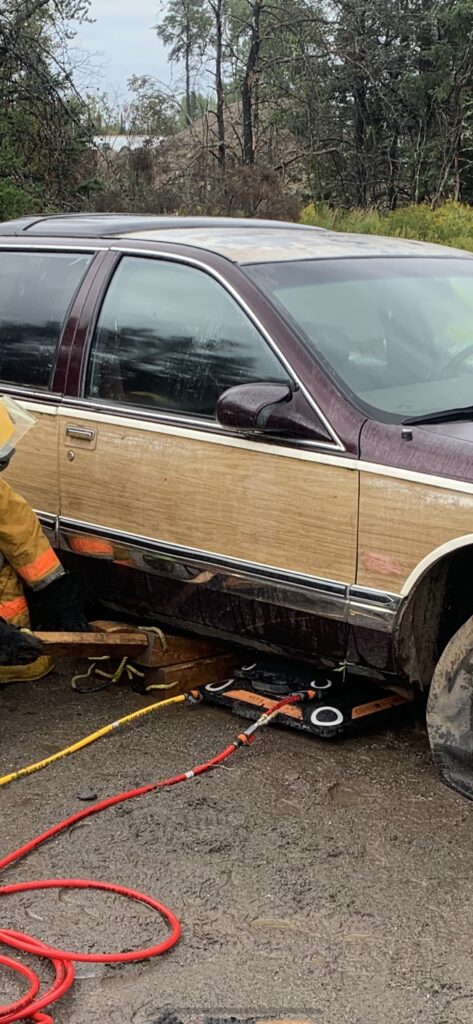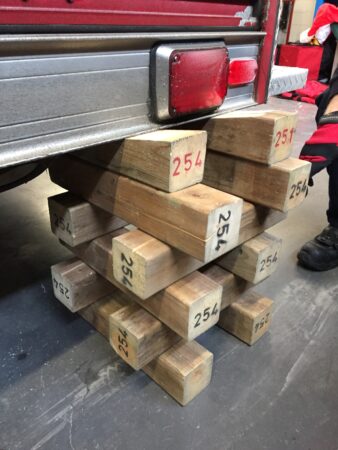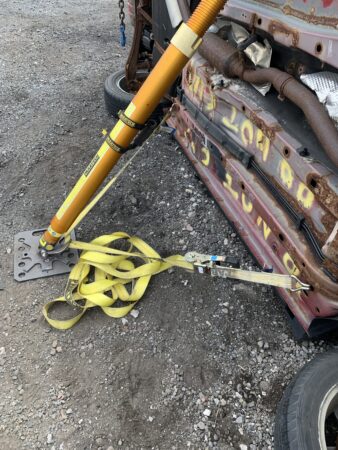
Extrication Tips: The finer things
By Chad Roberts
Features canadian firefighter firefighter firefighter training training Always try and lift with two bags, one on top of the other so they can cradle each other for better stability. Photo credit: Chad Roberts
Always try and lift with two bags, one on top of the other so they can cradle each other for better stability. Photo credit: Chad Roberts In the last couple articles, we covered many different things in regard to heavy lifting and stabilizing. We talked about different strut capabilities, lifting vs. stabilizing and hydraulic vs. pneumatic. Knowing these differences are important when we are dealing with extreme loads that have the capability of crushing victims or rescuers if calculated improperly.
To wrap up this lifting topic, I thought I’d spend a little more time on some of the finer details and tips that will help keep you out of trouble when it comes to your next lifting call.
Make sure you have packed enough punch to handle the weight capacities you are going up against. Just like operations in rope rescue, heavy rescue and strut work must build in safety factors. This is something that your department or authority will ultimately decide on, but for a lot of rescue systems, a 4:1 safety factor is generally an acceptable practice. Be sure to double check your equipment as some manufacturers have already built that safety factor into their equipment.
If using struts for your lift, keep in mind the weak points of these systems. Generally, this weak point is where and how your strut is attached to either the load or another strut. When it comes to lifting heavy loads, your webbing ratchet straps will be no match for these weights. A good place to start is by using a grade 80 chain or higher to safely meet the ratings you’ll need.

Box cribs get their rating by contact points, with most having 4 points(if their all contacting the load). Photo credit: Chad Roberts
If the situation you are dealing with requires air bags instead of struts, make sure you aim for the highest rated bag you have in your cache. As your lift height increases and less of the bag is contacting the load, your lifting capacity will decrease. Although there are many new options on the market that have a plate sewn into the bag to help reduce this potential “power curve” issue, there are two ways you can try to lessen this problem. The first way is to make sure you always try and lift with two bags, one on top of the other so they can cradle each other for better stability. Secondly, if you need to increase your lifting capacity, try using another bag with the same lifting capabilities side by side. This will essentially double your lifting capacity. Be sure to use the same weight rated bags, as with any lifting operation with air bags, your overall lifting ability is dictated by your lowest rating in the system.
Make sure you have packed enough punch to handle the weight capacities you are going up against.
If you’re using a pneumatic strut to stabilize your load, make sure you know its specified rating and safety factor. If you’re limited to wood cribbing, make sure you fully understand its weight rating and their capacities.
If box cribbing is your choice, remember the following finer details. Box cribs get their rating by contact points, with most having four points. Four-by-four contact points are rated at 6,000 lbs. each, so if your entire crib stack is supporting the load, your capacity is at 24,000 lbs.
If this is not enough for your operation there are a few ways to bump this up. Start off by going to a larger dimensional 6×6 box crib. This will bump up your contact rating to 15,000 lbs. per point for your entire crib stack. If upgrading your box crib isn’t an option, add more cribbing to each level of your 4×4 box crib. Most operations utilize two 4×4’s per level, so try adding in a third, which will give you five more contact points and another 30,000 lbs. Time and proper consideration must be given to this, as with almost all lifting operations, the bulk of the weight of your lift will be resting on your cribbing once the appropriate lift height is achieved.

For singular strut usage, run the strap from one attachment point, through the base of the strut and finish off at your last attachment point. Photo credit: Chad Roberts
One final tip: when you only have two struts and are dealing with the stabilization of a side resting vehicle that requires struts on both sides, you may have to split your struts. This can be successfully accomplished by putting the strut in the middle of the side resting car and run the strap from one attachment point, through the base of the strut and to your last attachment point. This will give you a stable option for a situation that may usually call for three to four struts, and your truck is only carrying two.
All in all, the world of heavy lifting is ever changing. Without understanding these finer details, we will surely be putting our patients and rescuers in a dangerous situation.
Keep training, take your time and lift safely.
Chad Roberts is a firefighter in Oakville, Ont. He is a member of the Oakville extrication team and competes and trains across North America. Contact Chad at chadroberts12@gmail.com.
Print this page
Advertisement
- Firefighters use GPS to locate two people lost in Ottawa forest
- Fire consumes house in Winnipeg’s North End